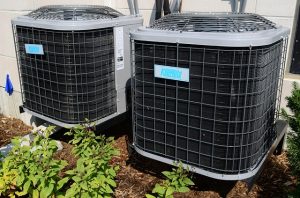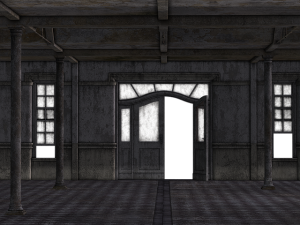A Mouse only needs an entry point as big as its head to access your home! Once they are in your home, mice are experts at hiding!
Have you seen this size of a mouse head?
Finding entry points is certainly no easy task, and when you consider the above information, we will not blame you if you want to call in an expert!
But you can do it! You can find common mice entry points, and you CAN use that knowledge to stop mice from getting into your precious home! All you need to know is where to begin looking.
How Do Mice Get In The House?
Mice will enter the house by stumbling upon one of the common entry points. Your job is to take a walk around your home to look for any of these entry points.
Once you have found them, you will need to seal them up! Keep reading for some excellent tips on sealing mouse entry points.
Each month I spend 20 minutes looking around my home for any entry points that may have appeared since the last time I checked. I do this because I want to find them before a mouse does.
I ensure that mice cannot get into my house by sealing these up. Therefore, I will not be a victim of a mouse infestation! Prevention is better than a cure.
8 Common Mice Entry Points
How do mice get into your house? Simple, by using one of the 8 most common entry points! Let’s take a look at these now.

Empty Holes

Over time, and because it is exposed to the elements, your home may end up with several holes.
It is vital that you regularly check around the perimeter of your home for any signs of wear and tear.
Ensure that you leave no place unchecked. It is crucial to check areas where you may have any plants or bushes growing. These areas are rarely checked but do leave your home exposed.
Mice have strong teeth, so even if a section of your home is beginning to crumble, mice can chew through and enter your home.
If you want to know how to find mouse holes, then put on your shoes and take a walk around your house!
Cable Holes

I am guilty of this!
Over time, I have changed over internet providers, phone providers, and cable providers. A technician has been out to install something new into my home each time.
Each change has the potential to leave a redundant cable entering my home. Instead of filling the hole, I left them. Leaving gaps in your home means leaving the biggest mice entry points exposed. Mice will take advantage. Before you know it, you will have mice in your attic, and you will be lying awake at night wondering if the mice will get into your bed!
If you want to know how to track where mice are entering your house, check around your home for any cable holes that are no longer needed!
Regularly check cable holes in use, too, because the hole may become weak due to the elements. If your cable holes get bigger, they can be used as an entry point for mice.
Air Conditioning

Air conditioning units need large holes to pass through the equipment.
Check around the installation for any small gaps around the edge because mice can easily enter using these edges! As I said above, mice only need a small area to gain access, so think about that as you perform your checks.
Roof Holes

It is time to get the ladder out! If you want to know how to keep mice out of your home, you cannot avoid checking your roof.
Mice are excellent climbers, and will happily traverse the side of your home to find an entry point.
This is especially true if you have overgrown trees growing close to your home. The tree will make it easier for the mice to reach the roof.
When you check your roof, ensure you cover the whole perimeter because if you do not find the holes, the mice will!
Check around the guttering, and check where the roof meets the walls. These are the entry points that mice will look for when trying to get into your home.
If you can’t find where mice are getting into your house, the answer is probably going to be near your roof!
Door/Window Frame Gaps

Poorly fitted windows can leave gaps around the edges. This is also true if your house is old and your windows have not been replaced for years.
Ensure that you check around each window and door to see if there are any holes small enough for mice to enter.
Your windows and doors may also have ventilation flaps, which can be an entry point for mice. Check these flaps to see if they are big enough to let a mouse in. I have just checked mine, and I can see a mesh-like material blocking access to the inside of the house. The fact that the mesh has not been chewed shows that mice have not used them, so ensure that you check these regularly.
Outlets

Like cable holes, there are likely to be some ventilation points around your house that can be used as a mouse entry point.
Outlets may be in place for your clothes dryer, or ventilation, especially in your attic.
The best way to seal mouse holes such as this is by using some mouse-proof wire mesh. Mice will find the mesh difficult to chew.
Open Doors/Windows

Leaving your doors and windows open is asking for trouble! When you look at sealing your house from mice, do not forget the most obvious entry points.
It is common for windows to be left open to ventilate and cool your house down in hot weather. During the day, this is not too much of a problem, especially if you are at home while they are open.
Leaving your windows open at night is a huge entry point for mice, and they will take advantage.
Open windows will be a welcome sight for mice, and you are also leaving your house exposed to the bad folks of this world!
You may think leaving the upper windows open is okay, but remember that mice are excellent climbers! They will find an open window and use it as an entry point.
Holes From Your Energy Source

Whether you use gas, solar panels, or electricity, your energy supply will need to enter your home somewhere.
Check around the area where your energy source enters your home. It is a perfectly valid mice entry point if they have been poorly fitted or have not been checked for many years.
Have You Found a Mouse Entry Point? Here Is What You Do Now
Let’s look at some of the best ways to seal mouse holes!
If you have found one, or maybe more, mice entry points, it is time to block them up to stop mice from getting into your home! Knowing where mice are coming into your house is one thing, but it is not much use unless you are willing to block these entry points.
Here is a list of items that I use to block mice entry points:
- Mouse Proof Wire Mesh: Wire mesh is vital for holes around ventilation units and outlets in your home. Mice will find it a challenge to chew through metal; although it is possible, it is a challenge they may find too much.
- Spackling/Filler: Use filler to block small holes, such as redundant cable holes. Ensure that you fill the hole inside and outside your property. Leaving a hole in your home will expose it to mice infestations, so you must fill any holes as soon as they become redundant.
- Steel Wool: For larger holes in your home, it is worth plugging the hole with wire wool, too, because if mice chew through the filler, they will stop as soon as they get to the wire wool. Although mice can chew through wire wool, the small metal sharps get stuck in their teeth, making the experience too painful. Wire wool is excellent for stopping mice and rats!
- Mouse Traps: I always have a small number of top-rated mouse traps set up in my attic, just in case I miss a mouse entry point and one of them (or more) finds their way into my home. The traps are checked regularly in case they have caught a mouse!
I have 6 traps in total, some large traps, and some small traps. When dealing with mice, it is important to set up some smaller traps to catch the smaller mice.
How To Track Where Mice Are Entering A House
Tracking where mice enter a house is simple, especially if you have identified the entry points already.
Simply scatter some talc or flour around the entry point. After 2 days, check the area where you have scattered the talc to see if you have any footprints.
If the entry point has a breeze that may interfere with the talc, place a loaded mouse trap near the entry point. Then, you will find out which entry point they are using!
Conclusion
Now that you know how to look for mice entry points, it is time to go outside and thoroughly check the perimeter of your home!
Instead of scratching your head wondering how to find out where a mouse is coming from, get outside and check your property. To understand how to find out where a mouse is getting in, you need to lace up your boots and check your house.
It is vital that you remove the entry points to ensure your home remains mouse free.
Once you have secured any weakness in your home, set up regular checks every month. Do this to ensure that no new mice entry points need to be fixed. That is how you keep mice out of your home!
Also, I suggest setting up some mouse traps in your attic, just if you get a mouse that has found an entry point you may have missed. As mentioned above, I have several traps, just in case!
Good luck!








